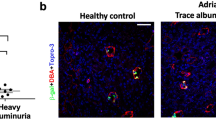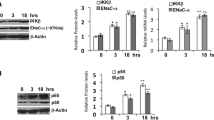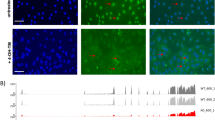Abstract
Crystallin zeta (CRYZ) is a phylogenetically restricted water-soluble protein and provides cytoprotection against oxidative stress via multiple mechanisms. Increasing evidence suggests that CRYZ is high abundantly expressed in the kidney where it acts as a transacting factor in increasing glutaminolysis and the Na+/K+/2Cl– cotransporter (BSC1/NKCC2) expression to help maintain acid–base balance and medullary hyperosmotic gradient. However, the mechanism by which CRYZ is regulated in the kidney remains largely uncharacterized. Here, we show that CRYZ is a direct target of farnesoid X receptor (FXR), a nuclear receptor important for renal physiology. We found that CRYZ was ubiquitously expressed in mouse kidney and constitutively expressed in the cytoplasm of medullary collecting duct cells (MCDs). In primary cultured mouse MCDs, CRYZ expression was significantly upregulated by the activation and overexpression of FXR. FXR-induced CRYZ expression was almost completely abolished in the MCD cells with siRNA-mediated FXR knockdown. Consistently, treatment with FXR agonists failed to induce CRYZ expression in the MCDs isolated from mice with global and collecting duct–specific FXR deficiency. We identified a putative FXR response element (FXRE) on the CRYZ gene promoter. The luciferase reporter and ChIP assays revealed that FXR can bind directly to the FXRE site, which was further markedly enhanced by FXR activation. Furthermore, we found CRYZ overexpression in MCDs significantly attenuated hypertonicity-induced cell death possibly via increasing Bcl-2 expression. Collectively, our findings demonstrate that CRYZ is constitutively expressed in renal medullary collecting duct cells, where it is transcriptionally controlled by FXR. Given a critical role of FXR in MCDs, CRYZ may be responsible for protective effect of FXR on the survival of MCDs under hypertonic condition during dehydration.







Similar content being viewed by others
References
Ananthanarayanan M, Balasubramanian N, Makishima M, Mangelsdorf DJ, Suchy FJ (2001) Human bile salt export pump promoter is transactivated by the farnesoid X receptor/bile acid receptor. J Biol Chem 276:28857–28865. https://doi.org/10.1074/jbc.M011610200
Bansal N, Kadamb R, Mittal S, Vig L, Sharma R, Dwarakanath BS, Saluja D (2011) Tumor suppressor protein p53 recruits human Sin3B/HDAC1 complex for down-regulation of its target promoters in response to genotoxic stress. PLoS One 6:e26156. https://doi.org/10.1371/journal.pone.0026156
Bazzi MD, Rabbani N, Duhaiman AS (2001) High-affinity binding of NADPH to camel lens zeta-crystallin. Biochim Biophys Acta 1544:283–288. https://doi.org/10.1016/s0167-4838(00)00228-4
Borras T, Persson B, Jornvall H (1989) Eye lens zeta-crystallin relationships to the family of "long-chain" alcohol/polyol dehydrogenases. Protein trimming and conservation of stable parts. Biochemistry 28:6133–6139. https://doi.org/10.1021/bi00441a001
Chiang JY, Kimmel R, Weinberger C, Stroup D (2000) Farnesoid X receptor responds to bile acids and represses cholesterol 7alpha-hydroxylase gene (CYP7A1) transcription. J Biol Chem 275:10918–10924. https://doi.org/10.1074/jbc.275.15.10918
Fujii Y, Watanabe K, Hayashi H, Urade Y, Kuramitsu S, Kagamiyama H, Hayaishi O (1990) Purification and characterization of rho-crystallin from Japanese common bullfrog lens. J Biol Chem 265:9914–9923
Gai Z, Chu L, Xu Z, Song X, Sun D, Kullak-Ublick GA (2017) Farnesoid X receptor activation protects the kidney from ischemia-reperfusion damage. Sci Rep 7:9815. https://doi.org/10.1038/s41598-017-10168-6
Kadamb R, Mittal S, Bansal N, Batra H, Saluja D (2013) Sin3: Insight into its transcription regulatory functions. Eur J Cell Biol 92:237–246. https://doi.org/10.1016/j.ejcb.2013.09.001
Lapucci A, Lulli M, Amedei A, Papucci L, Witort E, Di Gesualdo F, Bertolini F, Brewer G, Nicolin A, Bevilacqua A, Schiavone N, Morello D, Donnini M, Capaccioli S (2010) zeta-Crystallin is a bcl-2 mRNA binding protein involved in bcl-2 overexpression in T-cell acute lymphocytic leukemia. FASEB J 24:1852–1865. https://doi.org/10.1096/fj.09-140459
Lee FY, Kast-Woelbern HR, Chang J, Luo G, Jones SA, Fishbein MC, Edwards PA (2005) Alpha-crystallin is a target gene of the farnesoid X-activated receptor in human livers. J Biol Chem 280:31792–31800. https://doi.org/10.1074/jbc.M503182200
Lee H, Zhang Y, Lee FY, Nelson SF, Gonzalez FJ, Edwards PA (2006) FXR regulates organic solute transporters alpha and beta in the adrenal gland, kidney, and intestine. J Lipid Res 47:201–214. https://doi.org/10.1194/jlr.M500417-JLR200
Li S, Qiu M, Kong Y, Zhao X, Choi HJ, Reich M, Bunkelman BH, Liu Q, Hu S, Han M, Xie H, Rosenberg AZ, Keitel V, Kwon TH, Levi M, Li C, Wang W (2018) Bile acid G protein-coupled membrane receptor TGR5 modulates aquaporin 2-mediated water homeostasis. J Am Soc Nephrol 29:2658–2670. https://doi.org/10.1681/ASN.2018030271
Lulli MLR, Lapucci A, Papucci L, Capaccioli S, Schiavone N (2016) Involvement of ζ-crystallin in acidic microenvironment of melanoma: In: 3rd Joint meeting of pathology and laboratory medicine. Am J Pathol S18
Lulli M, Nencioni D, Papucci L, Schiavone N (2019) Zeta-crystallin: a moonlighting player in cancer. Cell Mol Life Sci 77:965–976. https://doi.org/10.1007/s00018-019-03301-3
Makishima M, Okamoto AY, Repa JJ, Tu H, Learned RM, Luk A, Hull MV, Lustig KD, Mangelsdorf DJ, Shan B (1999) Identification of a nuclear receptor for bile acids. Science 284:1362–1365. https://doi.org/10.1126/science.284.5418.1362
Malik A, Albogami S, Alsenaidy AM, Aldbass AM, Alsenaidy MA, Khan ST (2017) Spectral and thermal properties of novel eye lens zeta-crystallin. Int J Biol Macromol 102:1052–1058. https://doi.org/10.1016/j.ijbiomac.2017.04.101
Mörner CT (1894) Untersuchungen der Proteinsubstanzen in den lichtbrechenden Medien des Auges. Z Physiol Chem 18:223–256
Porte S, Moeini A, Reche I, Shafqat N, Oppermann U, Farres J, Pares X (2011) Kinetic and structural evidence of the alkenal/one reductase specificity of human zeta-crystallin. Cell Mol Life Sci 68:1065–1077. https://doi.org/10.1007/s00018-010-0508-2
Rao PV, Krishna CM, Zigler JS Jr (1992) Identification and characterization of the enzymatic activity of zeta-crystallin from guinea pig lens. A novel NADPH:quinone oxidoreductase. J Biol Chem 267:96–102
Rao PV, Horwitz J, Zigler JS Jr (1994) Chaperone-like activity of alpha-crystallin. The effect of NADPH on its interaction with zeta-crystallin. J Biol Chem 269:13266–13272
Schroeder JM, Liu W, Curthoys NP (2003) pH-responsive stabilization of glutamate dehydrogenase mRNA in LLC-PK1-F+ cells. Am J Physiol Ren Physiol 285:F258–F265. https://doi.org/10.1152/ajprenal.00422.2002
Su W, Cao R, Zhang XY, Guan Y (2020) Aquaporins in the kidney: physiology and pathophysiology. Am J Physiol Ren Physiol 318:F193–F203. https://doi.org/10.1152/ajprenal.00304.2019
Szutkowska M, Vernimmen C, Debaix H, Devuyst O, Friedlander G, Karim Z (2009) Zeta-crystallin mediates the acid pH-induced increase of BSC1 cotransporter mRNA stability. Kidney Int 76:730–738. https://doi.org/10.1038/ki.2009.265
Tang A, Curthoys N (2001) Identification of -crystallin/NADPH:quinone reductase as a renal glutaminase mRNA pH response element-binding protein. J Biol Chem 276:21375–21380. https://doi.org/10.1074/jbc.M101941200
Taylor L, Curthoys NP (2004) Glutamine metabolism: role in acid-base balance*. Biochem Mol Biol Educ 32:291–304. https://doi.org/10.1002/bmb.2004.494032050388
Wang B, Zhang H, Luan Z, Xu H, Wei Y, Zhao X, Xing M, Huo X, Zhang J, Su W, Guan Y, Zhang X (2020) Farnesoid X receptor (FXR) activation induces the antioxidant protein metallothionein 1 expression in mouse liver. Exp Cell Res:111949. https://doi.org/10.1016/j.yexcr.2020.111949
Xu S, Huang S, Luan Z, Chen T, Wei Y, Xing M, Li Y, Du C, Wang B, Zheng F, Wang N, Guan Y, Gustafsson J-Å, Zhang X (2018) Farnesoid X receptor is essential for the survival of renal medullary collecting duct cells under hypertonic stress. Proc Natl Acad Sci U S A 115:5600–5605. https://doi.org/10.1073/pnas.1803945115
Zhang X, Huang S, Gao M, Liu J, Jia X, Han Q, Zheng S, Miao Y, Li S, Weng H, Xia X, Du S, Wu W, Gustafsson JA, Guan Y (2014) Farnesoid X receptor (FXR) gene deficiency impairs urine concentration in mice. Proc Natl Acad Sci U S A 111:2277–2282. https://doi.org/10.1073/pnas.1323977111
Zhang XY, Wang B, Guan YF (2016) Nuclear receptor regulation of aquaporin-2 in the kidney. Int J Mol Sci 17. https://doi.org/10.3390/ijms17071105
Zhu Y, Liu H, Zhang M, Guo GL (2016) Fatty liver diseases, bile acids, and FXR. Acta Pharm Sin B 6:409–412. https://doi.org/10.1016/j.apsb.2016.07.008
Funding
This work was supported by the National Natural Science Foundation of China Grants 81722010, 81970606 (to X.Z.); 91639201 and 81970595 (to Y.G.); 81601174 (to Z. L.); 81900267 (to H.X.) and the Liaoning BaiQianWan Talents Program.
Author information
Authors and Affiliations
Corresponding authors
Ethics declarations
Conflict of interest
The authors declare that they have no conflict of interest.
Additional information
Publisher’s note
Springer Nature remains neutral with regard to jurisdictional claims in published maps and institutional affiliations.
Electronic supplementary material
ESM 1
(PDF 629 kb).
Rights and permissions
About this article
Cite this article
Alam, G., Luan, Z., Gul, A. et al. Activation of farnesoid X receptor (FXR) induces crystallin zeta expression in mouse medullary collecting duct cells. Pflugers Arch - Eur J Physiol 472, 1631–1641 (2020). https://doi.org/10.1007/s00424-020-02456-4
Received:
Revised:
Accepted:
Published:
Issue Date:
DOI: https://doi.org/10.1007/s00424-020-02456-4




